sysmon
Sysmon
Sysmon(System monitor)微软提供的轻量级的系统监控工具,能根据自定义编写配置文件监控并记录进程创建、网络连接、文件操作、驱动情况等等详细信息,相关的详细信息会写入到事件查看器——应用程序和服务日志——Windows——Sysmon日志事件里面去,从功能上来看,Sysmon类似于HIDS,依托于Windows内核态注册回调并通过ETW存储展示Windows日志。
Windows系统主要分为用户态(ring3)和内核态(ring0):
- ring3:普通应用程序层级,权限低,不能直接操作系统底层资源(比如进程创建、文件读写),适合做数据收集、解析、展示非底层操作。
- ring0:驱动程序运行的层级,能直接访问系统内核资源,能监控所有底层操作(比如进程创建、文件底层读写),但风险高(写得不好会导致系统蓝屏),适合做底层数据采集。
Sysmon也分成这样的两层,通过内核驱动捞底层原始数据,用户态负责补全数据并将原始数据翻译成易懂的日志
| 层级 | 运行的组件 | 核心职责 | 依赖 |
|---|---|---|---|
| ring3 用户态 | Sysmon 服务(exe 程序) | 1. 收集网络数据;2. 解析驱动传来的原始数据 | ETW(事件跟踪)、EventLog(事件日志) |
| 内核态驱动 | Minifilter 文件过滤驱动 | 1. 收集进程 / 线程 / 模块信息;2. 记录文件 / 注册表访问 | 进程回调、Minifilter、注册表回调 |
ring3:
Sysmon的用户态程序会订阅 Windows 的 “网络相关 ETW(Event Tracing for Windows) 事件(比如网络连接、端口监听、数据发送接收等),直接从系统层面捕获网络数据。- 驱动会把收集到的进程 / 文件 / 注册表原始数据,通过内核态→用户态的通信机制(比如事件对象、共享内存)传给
Sysmon用户态程序;用户态程序通过 EventLog的规范,把这些原始数据 翻译成结构化日志 —— 比如把PID对应到进程名、把内存地址转成实际的文件路径 / 注册表路径,最终生成包含时间戳、进程信息、操作对象、操作类型、结果的清晰日志。
ring1:
内核允许驱动注册回调,当系统中任何进程发生创建、退出或者进程加载了新模块(比如 DLL 文件),内核会立刻通知驱动,驱动就能捕获到关键信息:
- 进程信息:PID、进程名、父进程 PID、进程路径、创建时间、退出时间;
- 线程信息:线程 ID、所属进程 PID、线程创建 / 退出时间;
- 模块信息:加载的 DLL/EXE 路径、模块名、加载时间、所属进程。
基于Minifilter,驱动能拦截所有进程的文件操作,记录:
- 操作进程:哪个进程在操作文件;
- 操作对象:文件的完整路径;
- 操作类型:创建、读取、写入、删除、重命名等;
- 操作结果:成功 / 失败(比如权限不足导致删除失败)。
内核支持注册表回调,驱动注册后,能拦截所有注册表操作:
- 操作进程:哪个进程在操作注册表;
- 操作对象:注册表的完整路径(比如 HKEY_LOCAL_MACHINE\SOFTWARE\XXX);
- 操作类型:创建、读取、写入、删除等;
- 操作结果:成功 / 失败。
总的来说,Sysmon是两层架构的协作流程:
- 驱动采集底层数据:通过进程回调 + Minifilter + 注册表回调,收集原始数据。
- 数据传递给用户态:通过内核->用户态的通信通道,传给Sysmon服务
- 用户态补充+解析:通过ETW补充采集网络数据,同时接收驱动传来的二进制数据,并解析EventLog
- 生成最终的日志:整合以上的数据,写入日志库中供用户查看
Sysmon语法字段
Sysmon事件对象:
| 事件 ID | 事件名称 | 核心监控内容 |
|---|---|---|
| 1 | ProcessCreate | 进程创建(记录完整命令行、父进程 ID、进程路径、哈希值等) |
| 2 | ProcessCreateEx | 进程创建扩展信息(包含进程创建时的环境变量、令牌信息等详细数据) |
| 3 | NetworkConnect | 网络连接建立(记录源 IP / 端口、目标 IP / 端口、协议、进程信息等) |
| 4 | ServiceConfigurationChange | 服务配置变更(记录服务的创建、修改、删除或启动类型变更) |
| 5 | ProcessTerminate | 进程终止(记录进程 ID、名称及终止时间) |
| 6 | DriverLoad | 驱动加载(记录驱动路径、哈希值、签名信息,用于检测恶意驱动) |
| 7 | ImageLoad | 镜像加载(记录进程加载的 DLL 等模块路径、哈希值,检测 DLL 注入) |
| 8 | RemoteThreadCreate | 远程线程创建(记录跨进程创建线程的行为,常用于检测进程注入) |
| 9 | NetworkDisconnect | 网络连接断开(记录连接断开的进程、IP / 端口信息) |
| 10 | ProcessAccess | 进程访问(记录一个进程打开另一个进程的行为,如读取敏感进程内存) |
| 11 | FileCreate | 文件创建 / 覆盖(记录新建文件或覆盖已有文件的路径、进程信息) |
| 12 | RegistryEvent (CreateKey) | 注册表项创建(记录新建注册表项的路径、操作进程) |
| 13 | RegistryEvent (SetValue) | 注册表值修改(记录注册表值的修改操作,含键路径、新旧值) |
| 14 | RegistryEvent (DeleteKey) | 注册表项删除(记录删除注册表项的路径、操作进程) |
| 15 | FileCreateTime | 文件时间戳修改(记录文件创建时间、最后修改时间等被手动篡改的行为) |
| 16 | ServiceConfigurationChange (旧版) | 服务配置变更(部分旧版 Sysmon 使用,新版建议用 ID 4) |
| 17 | PipeEvent (Create) | 命名管道创建(记录进程创建的命名管道,用于检测进程间隐蔽通信) |
| 18 | PipeEvent (Connect) | 命名管道连接(记录进程连接到命名管道的行为) |
| 19 | WmiEvent (Filter) | WMI 筛选器创建(记录 WMI 筛选器的创建,检测通过 WMI 的持久化恶意行为) |
| 20 | WmiEvent (Consumer) | WMI 消费者创建(记录 WMI 消费者的创建,常与恶意持久化相关) |
| 21 | WmiEvent (Binding) | WMI 绑定(记录 WMI 筛选器与消费者的绑定,用于检测 WMI 触发的恶意逻辑) |
| 22 | DNSQuery | DNS 查询(记录进程发起的 DNS 解析请求,含域名、查询结果 IP) |
| 23 | FileDelete | 文件删除(记录文件被删除的路径、操作进程) |
| 24 | FileDeleteDetected | 文件删除检测(通常由反病毒软件触发,记录被删除的恶意文件) |
| 25 | FileStreamCreate | 文件流创建(记录 NTFS 备用数据流的创建,用于检测隐藏在数据流中的恶意内容) |
| 26 | IntegrityCheck | 完整性检查(记录 Sysmon 配置或自身文件被修改的行为,检测工具被篡改) |
| 27 | PipeEvent (Disconnect) | 命名管道断开(记录命名管道连接的断开行为) |
| 28 | LoadImage | 镜像加载(与 ID 7 类似,部分版本中用于记录驱动或模块加载的扩展信息) |
| 29 | CreateRemoteThread | 远程线程创建(与 ID 8 类似,部分版本中细化远程线程创建的监控) |
condition语法:
| 条件 | 描述 |
|---|---|
| is | 默认值,值相等 |
| is any | 字段是用分号分隔的值中的一个 |
| is not | 值不同 |
| contains | 字段包含此值 |
| contains any | 字段包含用分号分隔的值中的任意一个 |
| contains all | 字段包含用分号分隔的所有值 |
| excludes | 字段不包含此值 |
| excludes any | 字段不包含用分号分隔的值中的一个或多个 |
| excludes all | 字段不包含用分号分隔的任何值 |
| begin with | 字段以此值开头 |
| end with | 字段以此值结尾 |
| not begin with | 字段不以此值开头 |
| not end with | 字段不以此值结尾 |
| less than | 字典序比较结果小于零(即按字典顺序,字段值小于目标值) |
| more than | 字典序比较结果大于零(即按字典顺序,字段值大于目标值) |
| image | 匹配镜像路径(完整路径或仅镜像名称)。例如:lsass.exe 会匹配 c:\windows\system32\lsass.exe |
常见的配置
监控网络连接
- 监控常见exe软件发起的网络连接
- 监控常见端口的网络连接
- 排查杀毒软件、回环地址、某些官方域名的网络连接
<Sysmon schemaversion="4.90">
<HashAlgorithms>*</HashAlgorithms>
<EventFiltering>
<RuleGroup name="networkmonitor" groupRelation="or">
<NetworkConnect onmatch="include">
<Image name="user" condition="begin with">C:\Users</Image>
<Image condition="begin with">C:\ProgramData</Image>
<Image condition="begin with">C:\Windows\Temp</Image>
<Image condition="end with">dll</Image>
<Image condition="image">java.exe</Image>
<Image condition="image">javaws.exe</Image>
<Image condition="image">python.exe</Image>
<Image condition="image">curl.exe</Image>
<Image condition="image">ncat.exe</Image>
<Image condition="image">nc.exe</Image>
<Image condition="image">cmd.exe</Image>
<Image condition="image">nslookup.exe</Image>
<Image condition="image">sc.exe</Image>
<Image condition="image">at.exe</Image>
<Image condition="image">certutil.exe</Image>
<Image condition="image">dsquery.exe</Image>
<Image condition="image">powershell.exe</Image>
<Image condition="image">powershell_ise.exe</Image>
<Image condition="image">wmic.exe</Image>
<Image condition="image">wscript.exe</Image>
<DestinationPort name="FTP" condition="is">21</DestinationPort>
<DestinationPort name="SSH" condition="is">22</DestinationPort>
<DestinationPort name="IMAP" condition="is">25</DestinationPort>
<DestinationPort name="POP" condition="is">110</DestinationPort>
<DestinationPort name="SMB" condition="is">445</DestinationPort>
<DestinationPort name="RDP" condition="is">3389</DestinationPort>
</NetworkConnect>
<NetworkConnect onmatch="exclude">
<Image name="defender" condition="begin with">C:\ProgramData\Microsoft\Windows Defender\</Image>
<Image name="360" condition="is">360safe.exe</Image>
<DestinationHostname condition="end with">.microsoft.com</DestinationHostname>
<DestinationIp condition="is">127.0.0.1</DestinationIp>
</NetworkConnect>
</EventFiltering>
</Sysmon>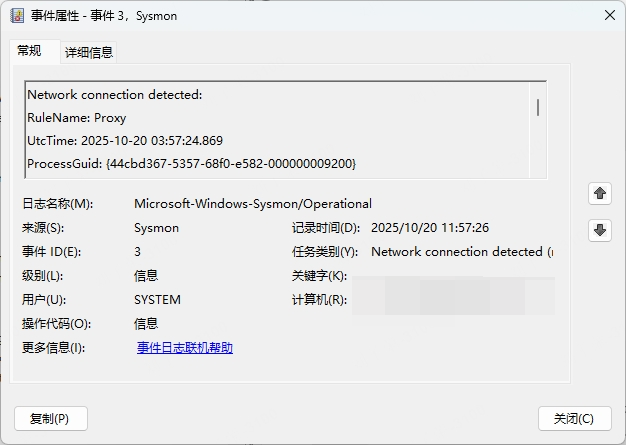
监控文件更改
- 监控用户目录、系统目录的文件
- 监控exe、dll文件的删除,排查临时文件缓存
- 排除系统wps、word等常用办公软件产生的文件监控
<Sysmon schemaversion="4.90">
<HashAlgorithms>*</HashAlgorithms>
<EventFiltering>
<RuleGroup name="filemonitor" groupRelation="or">
<FileCreate onmatch="include">
<TargetFilename condition="contains">C:\Users\</TargetFilename>
<TargetFilename condition="contains">C:\ProgramData\</TargetFilename>
<TargetFilename condition="contains">C:\Windows\System32\</TargetFilename>
</FileCreate>
<FileCreateTime onmatch="include">
</FileCreateTime>
<FileDelete onmatch="include">
<TargetFilename condition="end with">.exe</TargetFilename>
<TargetFilename condition="end with">.dll</TargetFilename>
</FileDelete>
<FileStreamCreate onmatch="include">
</FileStreamCreate>
<FileCreate onmatch="exclude">
<Image condition="end with">svchost.exe</Image>
<Image condition="end with">lsass.exe</Image>
</FileCreate>
<FileDelete onmatch="exclude">
<Image condition="end with">cleanmgr.exe</Image>
<TargetFilename condition="contains">AppData\Local\Temp\</TargetFilename>
</FileDelete>
<FileCreate onmatch="exclude">
<Image condition="end with">notepad.exe</Image>
<Image condition="end with">word.exe</Image>
<Image condition="end with">wps.exe</Image>
</FileCreate>
</RuleGroup>
</EventFiltering>
</Sysmon>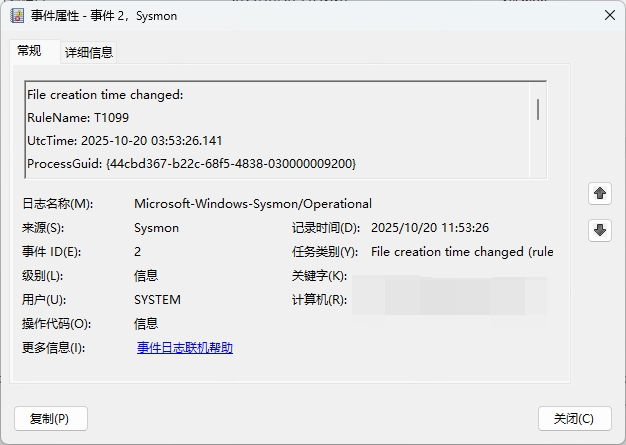
进程监控
监控所有的进程创建,排除关键的系统核心进程
<Sysmon schemaversion="4.90">
<HashAlgorithms>*</HashAlgorithms>
<EventFiltering>
<RuleGroup name="processmonitor" groupRelation="or">
<ProcessCreate onmatch="include">
<!--不填写默认监控所有-->
</ProcessCreate>
<ProcessCreate onmatch="exclude">
<Image condition="contains">C:\Windows\System32\</Image>
<Image condition="contains">C:\Windows\SysWOW64\</Image>
<Image condition="contains">C:\Windows\WinSxS\</Image>
<Image condition="contains">C:\Windows\Microsoft.NET\</Image>
<Image condition="end with">svchost.exe</Image> <!-- 系统服务宿主 -->
<Image condition="end with">lsass.exe</Image> <!-- 安全账户管理器 -->
<Image condition="end with">services.exe</Image> <!-- 服务控制管理器 -->
<Image condition="end with">winlogon.exe</Image> <!-- 登录进程 -->
<Image condition="end with">explorer.exe</Image> <!-- 资源管理器 -->
<Image condition="end with">taskhostw.exe</Image> <!-- 任务宿主(现代应用) -->
<Image condition="end with">csrss.exe</Image> <!-- 客户端服务器运行时进程 -->
<Image condition="end with">smss.exe</Image> <!-- 会话管理器 -->
<Image condition="end with">wininit.exe</Image> <!-- 系统初始化进程 -->
<Image condition="end with">SearchIndexer.exe</Image> <!-- 搜索索引进程 -->
</ProcessCreate>
<ProcessTerminate onmatch="include">
<Image condition="begin with">C:\Users</Image>
<Image condition="begin with">\</Image>
</ProcessTerminate>
</RuleGroup>
</EventFiltering>
</Sysmon>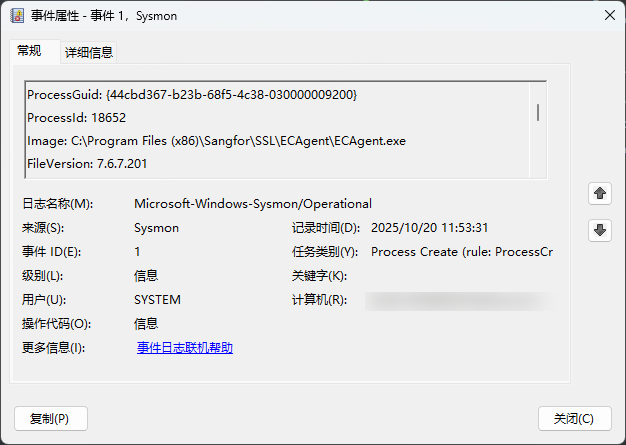
DNS解析监控
排除一些官方网站的dns解析
<Sysmon schemaversion="4.90">
<HashAlgorithms>*</HashAlgorithms>
<EventFiltering>
<RuleGroup name="dnsmonitor" groupRelation="or">
<QueryName condition="end with">.bing.com</QueryName>
<QueryName condition="end with">.baidu.com</QueryName>
<QueryName condition="end with">.google.com</QueryName>
<QueryName condition="is">localhost</QueryName>
<QueryName condition="end with">.windowsupdate.com</QueryName>
<QueryName condition="end with">.mozilla.com</QueryName>
<QueryName condition="end with">.mozilla.net</QueryName>
<QueryName condition="end with">.mozilla.org</QueryName>
</RuleGroup>
</EventFiltering>
</Sysmon>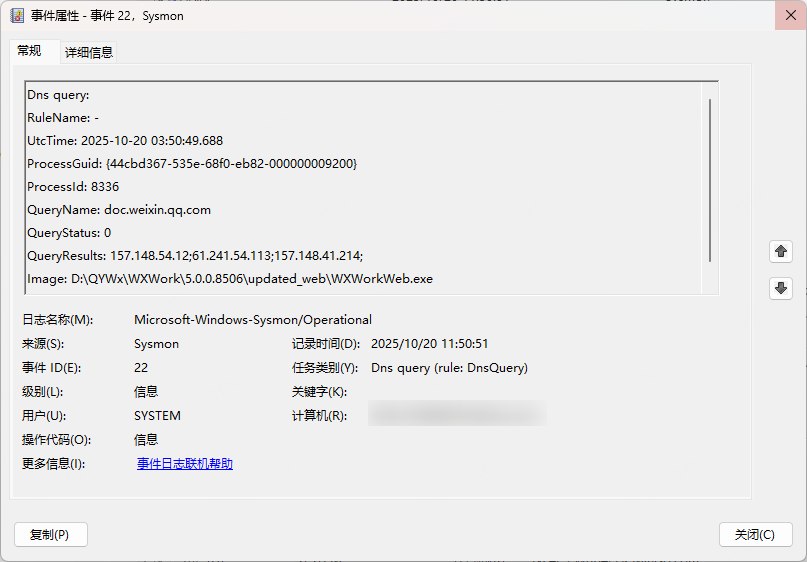
注册表监控
- 监控自启动项、安全相关的注册表路径
- 监控自启动值、UAC开关值的修改
- 监控安全软件、系统关键配置项的删除
- 排除正常的系统进程
<Sysmon schemaversion="4.90">
<HashAlgorithms>*</HashAlgorithms>
<EventFiltering>
<RuleGroup name="registrymonitor" groupRelation="or">
<RegistryEvent onmatch="include" eventType="CreateKey">>
<TargetObject condition="contains">HKLM\Software\Microsoft\Windows\CurrentVersion\Run</TargetObject>
<TargetObject condition="contains">HKLM\Software\Microsoft\Windows\CurrentVersion\RunOnce</TargetObject>
<TargetObject condition="contains">HKCU\Software\Microsoft\Windows\CurrentVersion\Run</TargetObject>
<TargetObject condition="contains">HKLM\Software\Microsoft\Windows NT\CurrentVersion\Winlogon</TargetObject>
<TargetObject condition="contains">HKLM\Software\Microsoft\Windows Defender</TargetObject>
</RegistryEvent>
<RegistryEvent onmatch="include" eventType="SetValue">
<TargetObject condition="contains">HKLM\Software\Microsoft\Windows\CurrentVersion\Run\</TargetObject>
<TargetObject condition="contains">HKCU\Software\Microsoft\Windows\CurrentVersion\Run\</TargetObject>
<TargetObject condition="contains">HKLM\Software\Microsoft\Windows\CurrentVersion\Policies\System\EnableLUA</TargetObject>
</RegistryEvent>
<RegistryEvent onmatch="include" eventType="DeleteKey">
<TargetObject condition="contains">HKLM\Software\Microsoft\Windows Defender</TargetObject>
<TargetObject condition="contains">HKLM\Software\Microsoft\Windows\CurrentVersion\Run</TargetObject>
</RegistryEvent>
<RegistryEvent onmatch="exclude">
<Image condition="end with">svchost.exe</Image>
<Image condition="end with">wuauclt.exe</Image>
<Image condition="end with">msiexec.exe</Image>
<TargetObject condition="contains">HKLM\Software\Microsoft\Windows\CurrentVersion\Installer\</TargetObject>
<TargetObject condition="contains">HKCU\Software\Microsoft\Windows\CurrentVersion\Explorer\</TargetObject>
<CommandLine condition="is">C:\Windows\system32\wermgr.exe -upload</CommandLine>
<ParentCommandLine condition="is">C:\windows\system32\wermgr.exe -queuereporting</ParentCommandLine>
<ParentImage condition="is">C:\Windows\system32\SearchIndexer.exe</ParentImage>
</RegistryEvent>
</RuleGroup>
</EventFiltering>
</Sysmon>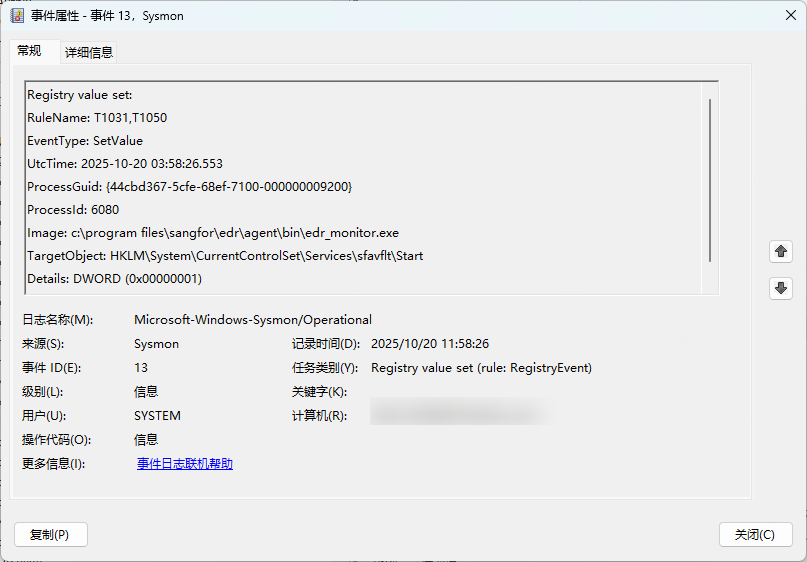
更全面的配置文件可以看:https://github.com/SwiftOnSecurity/sysmon-config
Winlogbeat
可以通过Winlogbeat将Sysmon的日志发送至SIEM平台中,这里以splunk为例。
Winlogbeat下载地址:https://www.elastic.co/cn/downloads/beats/winlogbeat
1、在splunk中配置HTTP事件接收器,以接收Winlogbeat发送的日志
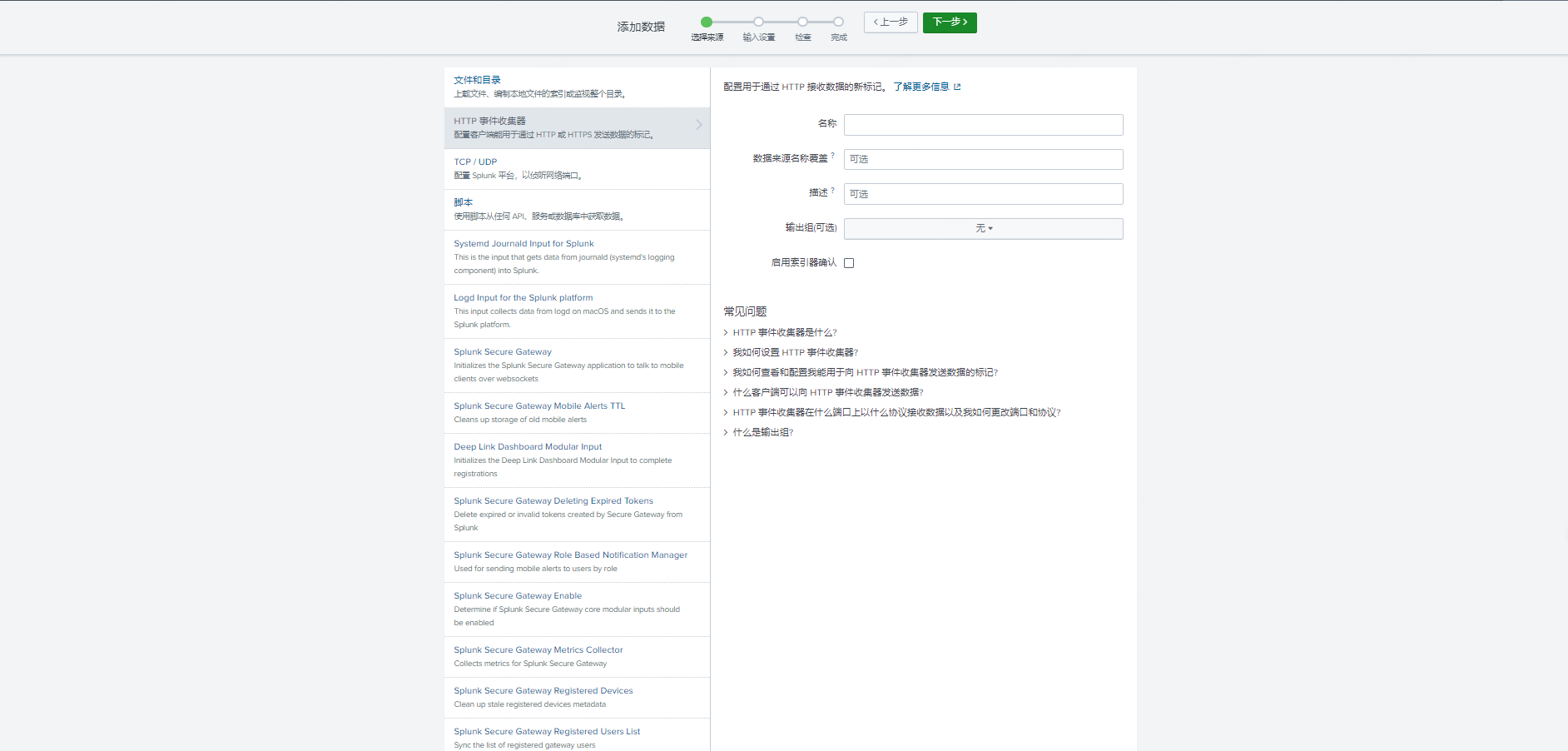
2、编辑C:\Program Files\Winlogbeat\winlogbeat.yml文件,以发送到splunk
############################# Winlogbeat ######################################
winlogbeat.event_logs:
- name: Microsoft-Windows-Sysmon/Operational
ignore_older: 24h
#event_id: 1,2
# ====================== Output to Splunk HEC ===============================
output.http:
hosts: ["https://host:port/services/collector"]
headers:
Authorization: Splunk token
index: "win_sysmon"
ssl.verification_mode: "none"
# ======================== Processors ======================================
processors:
- add_host_metadata: ~
#云环境- add_cloud_metadata: ~
#docker环境- add_docker_metadata: ~
# ======================== Logging ==========================================
logging.level: info
logging.to_files: true
logging.files:
path: C:\Program Files\Winlogbeat\logs定义
Winlogbeat-event_logs要发送的日志类型为Microsoft-Windows-Sysmon/Operational并忽略24 小时前的旧日志,配置为http的方式用于splunk接收日志,并通过processors加入自定义字段,如add_host_metadata加入主机的IP、主机名等信息作区分,并把Winlogbeat日志写入到C:\Program Files\Winlogbeat\logs文件当中。
总结
Sysmon 与 Winlogbeat的组合,可为办公终端构建一套轻量微型HIDS,通过实时获取HIDS的网络连接、进程、文件操作日志等到splunk中,再在splunk根据日志构建基础日志检测规则,实时发现在办公终端上的恶意行为,Sysmon低成本高性价、高细粒度、高自定义极有优势,与传统的商业EDR结合,能形成更为安全的互补。


文章标题:sysmon
文章链接:https://aiwin.net.cn/index.php/archives/4523/
最后编辑:2025 年 10 月 20 日 17:25 By Aiwin
许可协议: 署名-非商业性使用-相同方式共享 4.0 国际 (CC BY-NC-SA 4.0)